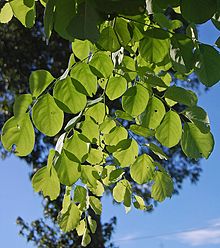- Dalbergia latifolia
-
Dalbergia latifolia 
Dalbergia latifolia growing as a street tree in Bogor, Java. Conservation status Scientific classification Kingdom: Plantae (unranked): Angiosperms (unranked): Eudicots (unranked): Rosids Order: Fabales Family: Fabaceae Subfamily: Faboideae Genus: Dalbergia Species: D. latifolia Binomial name Dalbergia latifolia
Roxb.Dalbergia latifolia (synonym Amerimnon latifolium) is an economically important timber species native to low elevation tropical monsoon forests of eastern India.[1][2] Some common names in English include blackwood, Bombay blackwood, rosewood, Roseta rosewood, East Indian rosewood, black rosewood, Indian palisandre, and Java palisandre.[1][2] Its Indian common names are beete, and sitsal.[1] The tree grows to 40 metres in height and is evergreen, but locally deciduous in drier subpopulations.[1][2]
Description and biology
The tree has grey bark that peels in long fibres, pinnately compound leaves, and bunches of small white flowers.[1] It grows as both an evergreen and a deciduous tree in the deciduous monsoon forests of India making the tree very drought hearty.
Haematonectria haematococca is a fungal pest of the tree, causing damage to the leaves and the heartwood in Javanese plantations.[3] In India, trees may be subject to serious damage from a species of Phytophthora, a water mold genus.[3]
Germplasm resources for D. latifolia are maintained by the Kerala Forest Research Institute in Thrissur, Kerala, India.[3]
Uses
The tree produces a hard, durable, heavy wood that, when properly cured, is durable and resistant to rot and insects.[3] It is grown as a plantation wood in both India and Java, often in dense, single species groves, to produce its highly desirable long straight bore.[3] Wood from the tree is used in premium furniture making and cabinetry, as veneer, as plywood, for outdoor furniture and as a bentwood, and for turning.[1][3]
 Chess pieces in Dalbergia latifolia rosewood
Chess pieces in Dalbergia latifolia rosewood
Under the Indian Forest Act, 1927 the exportation of lumber products from wild harvested D. latifolia is illegal.[2] There exists an international high demand and price for the wood due to its excellent qualities of having a long straight bore, its strength, and its high density.[3] However, the tree is slow-growing; Javanese plantations were started in the late nineteenth century, but, due to its slow growth, plantations have not expanded beyond Java and India.[3] Many once popular uses for D. latifolia wood have now been replaced with Dalbergia sissoo wood, particularly for cottage industries.
References
- ^ a b c d e f World Agroforestry Centre, Agroforestry Tree Database, http://www.worldagroforestrycentre.org/sea/Products/AFDbases/af/asp/SpeciesInfo.asp?SpID=1726, retrieved 2011-03-21
- ^ a b c d IUCN Redlist Dalbergia latifolia, http://www.iucnredlist.org/apps/redlist/details/32098/0
- ^ a b c d e f g h Louppe, D.; A A Oteng-Amoaka (2008). Plant resources of tropical Africa. 7(1), Timbers 1. PROTA Foundation. ISBN 9789057822094.
Categories:- IUCN Red List vulnerable species
- Dalbergia
- Trees of India
Wikimedia Foundation. 2010.


